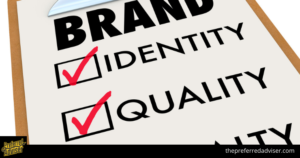Firms in the professional services business want to be known as trusted business partners that come to mind immediately.
In today’s more digital business environment, it’s harder to control brand reputation and build trust, especially for organizations that are newer or smaller than their competitors. Digital channels are causing the landscape to change, which enables small organizations to look bigger and reach more people.
People can develop opinions of a brand or organization without ever talking to an employee, which makes it difficult to communicate different messages. People are still the key to maintaining strong partnerships between companies, although they change jobs more frequently now, so the relationships need to be bigger than just the individual.
There is a need for more care and attention to differentiate a brand in order to succeed in the market. We prefer that people know our brand before we visit them.
That makes the relationship-building process much easier. Although you may not be the biggest or most well-known company in your industry, there are still ways to earn the trust and confidence of others in order to be invited in.
West Monroe is competing with a lot of different types of consulting organizations including the big four, firms with strong regional roots, specialists, and even start-ups.
This means that buyers have many more people vying for their attention and they are the only ones who get to choose who they allow in.
Our business and marketplace have changed over time, so we’ve had to adapt our approach to branding accordingly. There are eight strategies that West Monroe uses that can be applied to brand-building for many B2B firms.
1. Shift From Talking About What We Do to How and Why we Add Value

We are a business and technology consultancy that offers a full range of services. We “do” many things. if our brand only represented what we do, it would be difficult to send a clear message to the market. This can be a challenge for any service-based company since conveying what it is that they do can be difficult.
However, we recognized that what differentiates our firm is not what we do through research and client feedback. What separates us from others is how we do things differently and why that helps us create more value for clients.
Our company is motivated by a common purpose: to build the next generation of leaders. Our clear description of who we are-a firm with an uncommon blend of business consultants and deep technologists- allows us to be part of something bigger than a single office, practice, or project.
People in our organization found this messaging easy to remember and explain how our work creates value for clients. We differentiated ourselves from other companies by focusing on what we do, rather than simply trying to sell our product.
Although our brand messaging is strong, we need to keep adapting it to fit a constantly changing market. We do not expect to do a major rebranding every year, but we make subtle adjustments.
Our deep technologists help companies master the shift in technology going on around them by driving business results. For example, we recently elaborated on the specific ways our deep technologists help drive business results.
2. Bring the Brand to Life for Our People, So They Can be Brand Ambassadors

We, like most organizations, have formal brand standards and brand-building initiatives that are overseen by a central marketing team.
It is essential to ensure consistency in initiatives (e.g., proper use of logos and imagery) and to consistently apply our limited resources to a targeted market, so our messages reach the right people.
Though building a brand may feel disconnected from the daily work of those who deliver services, it is the responsibility of the entire organization, not just the marketing team. This perception can be perpetuated by the collective behavior of the organization’s people.
We have learned that emphasizing the role our people play in building brand engagement is important. Therefore, we invest some of our brand budget in engaging our employees as brand ambassadors.
We used to introduce brand updates to both our employees and the market simultaneously. Back in May 2015, we did a brand refresh that was all about the “uncommon blend.” Before we released the product to the public, we spent several months introducing it to our employees – intensively, through digital channels and by holding events in multiple offices.
Doing this allowed our employees to explain, in a positive and cheerful manner, how they combine clever business skills with advanced technical knowledge to meet every customer’s problem.
Our brand promise was brought to life in a personal way that inspired others to do the same.
3. Brand Identity

This is the phase where you take your brand and make it into something real. Your brand identity includes many of the most visible elements of a brand, including:
- Your name
- Your logo
- Tagline
- Color palette
- Imagery
- Writing style (voice)
- Business cards
- Stationery suite
- Business collateral
As part of a branding process, you will likely develop or refresh some of these elements.
Your brand identity is an opportunity to make your positioning visually and experientially distinct, including through a unique personality and voice.
It is an opportunity to make your brand stand out from your competitors and look different.
Most companies are happy to play it safe and stick to what they’re familiar with. blue is a popular color in every industry because it is seen as trustworthy, dependable, and committed.
This is why you will see similar images on many websites. This is one reason why most professional services brands are not memorable. Your brand identity is an opportunity to make a statement that makes you stand out from a crowd that is bland and homogenous.
Firms who are brave enough to be different can really benefit from a strong brand identity.
Brands Style and Voice Guidelines
It can be difficult to keep a brand’s identity the same over a long period of time. To fix these issues, many businesses make brand style guides that show how the brand should be put together and what is and is not allowed.
The guidelines can be all-encompassing, telling you how to use the brand in every situation, or they can be basic, leaving room for experimentation and variety.
Some firms develop a set of guidelines separate from others that describes their “voice” – the way words they use express a personality or attitude.
Firms use brand voice guidelines to ensure that their written materials have a consistent voice. They may suggest avoiding using overly technical language.
The guidelines might also discuss sentence structure and the type of vocabulary a writer should use. Is humor allowed? If so, voice guidelines should describe when and how.
Other companies produce guidelines that address more specific areas of writing such as grammar, spelling, and punctuation.
The Creative Brief
You should write a creative brief before you start developing your brand identity. The brief should spell out your assumptions and preferences.
What does your brand’s personality mean? How do convey your brand in color, imagery, typography?
You should only develop the creative brief after discussing your brand identity internally. It should represent a consensus view.
If you are working with an agency, they may lead the discussion and develop the brief for you. This means that they will take charge of the situation and communicate with you what is expected of you in order to create the project.
A creative brief should be written for each element of a brand’s identity.
If you are creating a new name, the guidelines should reflect your company’s desires and any boundaries that the naming team needs to be aware of to keep from exploring the wrong options and wasting time.
4. Brand Tools

You will need the following tools to promote your new brand. These tools will help you make your brand more visible and increase your expertise.
The tools you need to promote your brand will depend on the methods you plan to use. At the very least, you’ll want to pay attention to these two categories of tools:
Your Website
translating your brand strategy into a website that resonates with your target audiences.
It should also reflect your new brand identity. Your website should be given a lot of thought and care. Your logo is the most important part of your brand and marketing.
Your Business Development Toolkit
It’s important to use your new brand positioning and messaging to help your business development. What’s a business development toolkit?
Your brand is your collection of tools to communicate your company’s message and put your strategy into action. Here are just a few examples:
- Descriptions of your firm
- Service descriptions
- Video overview of your firm
- Signage
- Tradeshow booth
For more ideas about how to implement your brand strategy, read this blog post about the 10 most useful branding tools.
5. Brand Launch

How you introduce your new brand can have a significant effect on the success of your branding initiative — especially in the professional services industry.
In other words, you should have two introductions: one for your internal team and another for the outside world. There are two very different groups of people that require different treatments.
The Internal Brand Launch
If you don’t make an effort to explain your new brand to your team, it will be difficult for them to understand and get on board with it from the beginning.
Without professionals being involved in the decision-making process, and without having any insight into the reasoning behind those decisions, confusion and cynicism can set in. It is easy to criticize something you don’t understand.
We recommend that you introduce a program to educate your staff before you launch the program externally.
The rationale for the change is that the branding process was grounded in objective reasoning. A few research highlights to demonstrate this are that the branding process was based on market research, focus groups, and surveys. Here are a few topics you might want to cover:
- Why we needed a new brand and what opportunities it creates
- How the process worked (to show how much thought went into it)
- What the research revealed
- How the new brand speaks to our target audience(s)
- Why the new brand works (and why the process wasn’t an internal popularity contest)
There are many ways to roll out an internal brand. You can host a simple all-hands meeting or an elaborate celebration. An event or series of training sessions can help you improve your skills.
The location of the business can either be centralized in one area or spread out over multiple offices. You will need to decide what is best for your organization and culture. But don’t skip it.
Your team should understand the implications of the new brand, how it changes the image of the company, and what new opportunities it provides. A successful internal brand launch will generate support for your new brand from within your company, as well as excitement about the new brand.
The External Brand Launch
While it may not be what you would expect, working on building internal consensus around your brand is more important than focusing on an external rollout. One of the main benefits of an external launch is that it has the potential to create a lot of concentrated attention, even if that attention is only temporary.
When a new brand enters the market, it’s an opportunity to create a positive initial impression. It also provides a forum to explain what you stand for, how your firm has changed and why your firm matters to your audience.
You can choose a quieter, more gradual approach. You can either announce your brand to the public with a big event or press release, or you can do it more gradually.
Launch balloons, if you like. You can either roll out your brand quickly with a lot of fanfare, or you can do it slowly with little or no fanfare. In this scenario, your brand identity is developed over a period of time, with different elements of your brand being created over a course of weeks or months.
Which approach you choose is up to you. There is more potential for PR with the first option, but it requires more work to establish your brand from the beginning. The end result may not be as exciting as you originally hoped, but it allows you to grow your brand in a less stressed manner that feels more natural.
No matter how you introduce your brand to the public, it provides your business development team with talking points about your company – how you are changing and how your company is responding to the needs of the market.
Before releasing our new brand to the public, we made sure that our employees who provide services understood our new brand messaging and how it applied to their specific responsibilities.
Conclusion
How a branding or rebranding effort is carried out is critical to its success. In this article, we have provided a process for building a brand that has been proven to be effective.
Doing things quickly or cheaply may seem like it will save you time or money, but it could end up costing you more in the long run. It is easy for a branding initiative to get stuck in debate.
If you’re not careful, you could end up releasing a brand that is inaccurate or harmful. We keep our company values in front of people by sharing stories or distributing branded chargers at quarterly meetings. This helps people to remember what it is that “keeps us going.”

0 comments